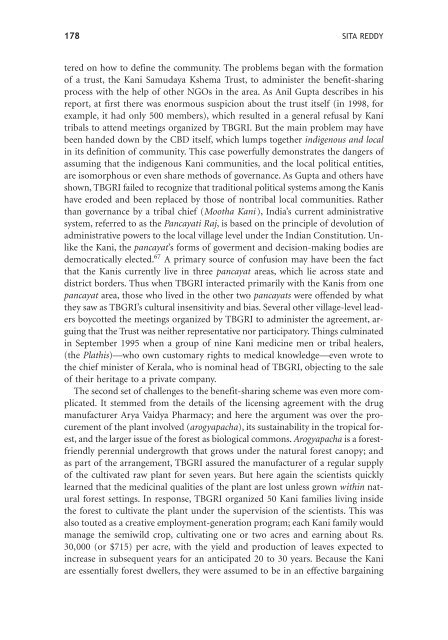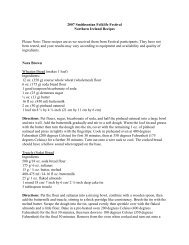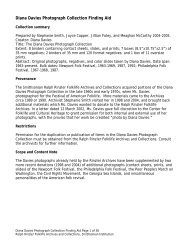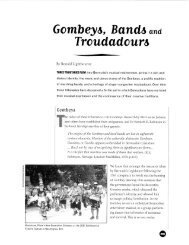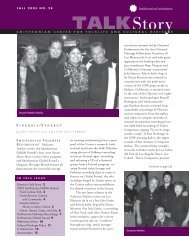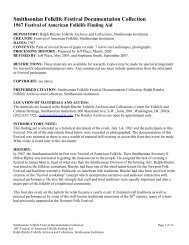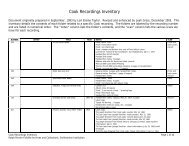Who Owns Traditional Medical Knowledge? - Smithsonian Center ...
Who Owns Traditional Medical Knowledge? - Smithsonian Center ...
Who Owns Traditional Medical Knowledge? - Smithsonian Center ...
Create successful ePaper yourself
Turn your PDF publications into a flip-book with our unique Google optimized e-Paper software.
178 SITA REDDY<br />
tered on how to define the community. The problems began with the formation<br />
of a trust, the Kani Samudaya Kshema Trust, to administer the benefit-sharing<br />
process with the help of other NGOs in the area. As Anil Gupta describes in his<br />
report, at first there was enormous suspicion about the trust itself (in 1998, for<br />
example, it had only 500 members), which resulted in a general refusal by Kani<br />
tribals to attend meetings organized by TBGRI. But the main problem may have<br />
been handed down by the CBD itself, which lumps together indigenous and local<br />
in its definition of community. This case powerfully demonstrates the dangers of<br />
assuming that the indigenous Kani communities, and the local political entities,<br />
are isomorphous or even share methods of governance. As Gupta and others have<br />
shown, TBGRI failed to recognize that traditional political systems among the Kanis<br />
have eroded and been replaced by those of nontribal local communities. Rather<br />
than governance by a tribal chief (Mootha Kani), India’s current administrative<br />
system, referred to as the Pancayati Raj, is based on the principle of devolution of<br />
administrative powers to the local village level under the Indian Constitution. Unlike<br />
the Kani, the pancayat’s forms of goverment and decision-making bodies are<br />
democratically elected. 67 A primary source of confusion may have been the fact<br />
that the Kanis currently live in three pancayat areas, which lie across state and<br />
district borders. Thus when TBGRI interacted primarily with the Kanis from one<br />
pancayat area, those who lived in the other two pancayats were offended by what<br />
they saw as TBGRI’s cultural insensitivity and bias. Several other village-level leaders<br />
boycotted the meetings organized by TBGRI to administer the agreement, arguing<br />
that the Trust was neither representative nor participatory. Things culminated<br />
in September 1995 when a group of nine Kani medicine men or tribal healers,<br />
(the Plathis)—who own customary rights to medical knowledge—even wrote to<br />
the chief minister of Kerala, who is nominal head of TBGRI, objecting to the sale<br />
of their heritage to a private company.<br />
The second set of challenges to the benefit-sharing scheme was even more complicated.<br />
It stemmed from the details of the licensing agreement with the drug<br />
manufacturer Arya Vaidya Pharmacy; and here the argument was over the procurement<br />
of the plant involved (arogyapacha), its sustainability in the tropical forest,<br />
and the larger issue of the forest as biological commons. Arogyapacha is a forestfriendly<br />
perennial undergrowth that grows under the natural forest canopy; and<br />
as part of the arrangement, TBGRI assured the manufacturer of a regular supply<br />
of the cultivated raw plant for seven years. But here again the scientists quickly<br />
learned that the medicinal qualities of the plant are lost unless grown within natural<br />
forest settings. In response, TBGRI organized 50 Kani families living inside<br />
the forest to cultivate the plant under the supervision of the scientists. This was<br />
also touted as a creative employment-generation program; each Kani family would<br />
manage the semiwild crop, cultivating one or two acres and earning about Rs.<br />
30,000 (or $715) per acre, with the yield and production of leaves expected to<br />
increase in subsequent years for an anticipated 20 to 30 years. Because the Kani<br />
are essentially forest dwellers, they were assumed to be in an effective bargaining


